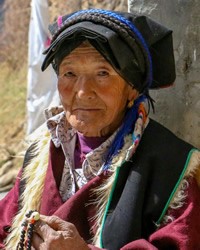Tibetan in Canada

Photo Source:
szyj351 - Pixabay
|
Send Joshua Project a map of this people group.
|
| People Name: | Tibetan |
| Country: | Canada |
| 10/40 Window: | No |
| Population: | 10,000 |
| World Population: | 1,104,400 |
| Primary Language: | Tibetan, Central |
| Primary Religion: | Buddhism |
| Christian Adherents: | 0.00 % |
| Evangelicals: | 0.00 % |
| Scripture: | Complete Bible |
| Ministry Resources: | Yes |
| Jesus Film: | Yes |
| Audio Recordings: | Yes |
| People Cluster: | Tibetan |
| Affinity Bloc: | Tibetan-Himalayan Peoples |
| Progress Level: |
|
Introduction / History
Written records of Tibetan history have survived from the seventh century AD, but it is known that nomadic tribes roamed Tibet as early as the second century BC. The cradle of Tibetan civilization is the Yarlung Valley area, about 80 kilometers (49 mi.) southeast of Lhasa. There, according to tradition, the union of a monkey and a she-devil created the Tibetan race. Around AD 600 the warrior-king of Yarlung, Namri Gampo, unified the clans of Tibet. He acquired a princess from Nepal and another one from China to be his wives. Under the persuasion of these two women, he combined the ancient Tibetan religion of Bon with Buddhist teachings.
For centuries the Chinese have claimed Tibet as an "unalienable part of China," despite Tibetans being culturally, historically, linguistically, and religiously distinct from Chinese. In the 1950s the Chinese took full control of Tibet, and many Tibetans have been fleeing ever since.
Canada had it's first contact with Tibet in 1898. A Canadian Protestant missionary couple went to Tibet, and they died along the way after their excursion was attacked and robbed leaving them with nearly nothing. This tragic incident gave Canadians an interest in Tibet that didn't germinate until the early 1970s when they began to allow their first Tibetan refugees to arrive in Canada. This started a new trend in Canada: Allowing non-Europeans to migrate to their country. More Tibetans from India arrived in Canada during the 2010s, though the total numbers are still small.
Where Are they Located?
Most Tibetans live in Tibet, which is now a province in southwestern China, but a sizable number fled to northern India with the Dalai Lama decades ago. Some of these are leaving India to start new lives in Canada. The Tibetans in Canada live primarily in Toronto, though there are others in Calgary and Vancouver.
What Are Their Lives Like?
With job training, most Tibetans in Canada have managed to find adequate work within five years. In the prairie provinces, they work as farm laborers. In the cities, they work in the service or crafts industries. Some are caregivers for the elderly.
What Are Their Beliefs?
The Tibetan Buddhist religion is the life-blood of the Tibetan people. It was placed over the powerful Tibetan religion of Bon, which is a mixture of magic, divination, demon worship, and shamanism. The patron saint of Tibet is Chenrezig, whose image has up to 11 heads and from 2 to 1,000 arms.
What Are Their Needs?
As Tibetans become established in Canada, they have managed to start their own cultural communities. For example, in 1981, they began the Tibetan Cultural Society of British Colombia, which is helping them to preserve and promote Tibetan culture and religion. Later in the 1980s they and their Canadian friends established an NGO called the Canada-Tibet Committee which is intended to raise awareness of the plight of the Tibetan people. Tibetan-Canadians now have their own youth groups.
Their main need remains: To find their way to the God who created them and wants to love them for eternity.
Prayer Points
Ask the Lord to call people who are willing to go to Canada and share Christ with Tibetans.
Ask the Holy Spirit to soften Tibetan hearts towards Christians so that they will be receptive to the gospel.
Pray that God will raise up loving Canadian Christians to reach out to their Tibetan neighbors.
Ask the Lord to raise up a strong disciple making movement among Tibetans in North America.